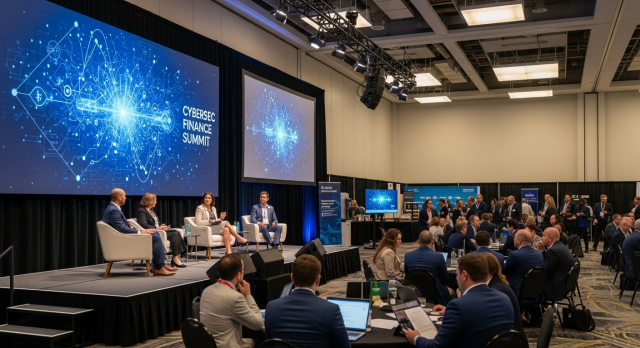Financial institutions are the most sensitive in the cyber world as they carry with them the most valuable assets and data, thus becoming the most vulnerable to a more advanced cyber attack. The cybersecurity finance conference has become one of the most critical fields where one will need to remain vigilant all the time, adjust, and be knowledgeable. The conferences focusing on this area of expertise are also valuable meeting points as security professionals, financial executives, and technology leaders gather to discuss the emergent threats and provide mutual defense strategies. The peculiarities of the financial sector (regulatory compliance, preserving customer trust, and so on) require specific expertise that is not inherent to the general practices of cybersecurity. With the adoption of digital banking, mobile payments, and online transactions as the new norm, the risks to financial system protection have never been greater.
-
Recognizing Emerging Threats Before They Strike Your Institution
Cyber criminals keep changing their strategies and inventing new methods of attacks that can bring down unsuspecting financial institutions. Threat intelligence experts convene at cybersecurity finance conferences to provide the most recent information regarding the emergent pattern of attacks, vulnerabilities, and criminal techniques that are used to attack the financial industry. The attendees also receive early warning of the threats that are yet to hit their organizations and hence take defensive action before they can be hit. In-depth technical descriptions of the latest attacks can help security teams to know how precisely the breaches were made and what security measures worked or failed. This prior knowledge has time benefits that can spell the difference between a thwarted intrusion and a devastating intrusion. Getting to know about threats at the same time as others who work in the same industry are informed about it provides a collective defense posture since the information will be shared fast through professional networks.
-
Understanding the Human Element in Financial Security Breaches
Technology has been a source of defense, yet the greatest vulnerability of most security constructs in protecting financial institutions has been anthropogenic. Finance conferences on cybersecurity focus more on the psychological and behavioural side of security, including how people become victims of phishing attacks, how social engineering can be used to manipulate people using trust, and why some people are more exposed to manipulation than others. The awareness and culture change sessions about security offer practical plans on how to convert the employees from being security liabilities into proactive defenders. The realization that the technical controls do not ensure that breaches are not occurring assists organizations in creating a balance in the security investments between the technology and human factors. The case studies used have shown that most successful attacks in these situations have compromised human vulnerability instead of technical vulnerability, and thus, there is a need to conduct thorough security training programs.
-
Navigating the Regulatory Maze with Expert Guidance
Different layers of security regulations governing financial institutions are based on jurisdiction, type of institution, and/or services being provided, which pose compliance challenges that are resource-consuming. The cybersecurity financial conferences hold regulatory experts and compliance gurus who can help security teams to interpret the complex requirements into feasible implementation advice that they can actually apply. The seminars discuss the upcoming regulatory amendments, enforcement practices, and pitfalls that have caused other institutions to be penalised. A better understanding of priorities at regulators when examining and auditing is beneficial because organizations can ensure that their compliance resources are focused on priorities that have the greatest impact. The discussions usually shed light on ambiguity in regulatory language and give interpretations in the light of real interactions of regulations and enforcement efforts. Determining how other peer institutions manage compliance issues provides alternative actions and best practices that can enhance effectiveness and efficiency.
-
Building Incident Response Capabilities through Shared Experiences
Any financial institution would wish to live without major security incidents, yet planning before they occur distinguishes the resilient organizations from those who end up suffering irreparably. Conferences on cybersecurity finance embrace much programming on incident response, including post-mortem discussion of attacks experienced by organizations that survived a major attack. These open debates show what was successful in responding to the crisis, all the decisions they found to be troublesome, and how they wish they could have done it. Using the experience of others enables security teams to optimize their incident response strategies, identify gaps in their capabilities, and rehearse decision-making structures before confronting actual emergencies. The technical forensics, containment, and recovery procedures present the technical skills that incident response teams can learn on the spot. Knowing the business impacts of various incident response decisions can make security leaders communicate well with the executives in times of crisis.
-
Evaluating Security Technologies with Independent Perspectives
The cybersecurity marketplace is flooded with vendors who have purported to have the solution to all security issues, and the scenario makes objective technology assessment very hard for busy security teams. Cybersecurity financial conferences offer neutral forums in which practitioners give candid evaluations on the technologies that they have adopted, and also evaluate some of the positive experiences as well as the negative ones. These peer views can be used to isolate marketing hype and real capability, and this can save organizations the huge cost of investing in solutions that do not work. The technical aspects of the deep dives into security architectures give insight into how various technologies fit together, what concealed cost arises during implementation, and which functionalities are the most significant in actual operating environments. The knowledge about technology constraints and difficulties that the real users have will give a realistic expectation that would enhance planning and budgeting.
-
Strengthening Your Security Team through Skill Development
Shortages in cybersecurity talent are evident, especially in financial institutions, where specialized knowledge levels are required, along with regulatory restrictions on the pool of candidates. Cybersecurity finance conferences are highly professional development events that allow security professionals to develop their technical expertise and strategic knowledge within a brief time. The training and workshops provide practical use of security tools, techniques, and methodologies that otherwise would be costly to get through formal training programs. Access to future technology, such as threat searching, malware investigation, and penetration testing, makes security professionals embrace further knowledge on specialized skills. The leadership courses enable the top security officials to acquire business cognizance, management, and strategic thinking competencies required to propel them to the executive.
Conclusion
Cybersecurity finance conferences are vital investments in institutional resilience, professional capacity, and defense against continually changing threats on a sector-wide basis. The intelligence o, contacts, and decision-making attained during such cyber in banking events have a direct security posture reinforcement effect on an organization and have the capability of developing human resources needed to establish the foundation of protection.






